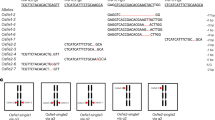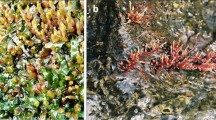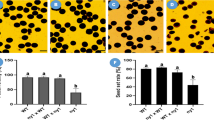Abstract
Polycomb group (PcG) protein MEDEA (MEA), one of the Enhancer of Zeste [E(z)], represses endosperm development in Arabidopsis until fertilization occurs. The Eulaliopsis binata is an apomictic species that forms endosperm asexually. Up to now, little is known about their homologs in apomictic plants. Here, E(z)-like genes EbEZ1 and EbEZ2 were cloned from Eulaliopsis. The EbEZs were ubiquitously expressed in vegetative and reproductive organs while their high mRNAs were accumulated in seed. In addition, up-regulated expression of EbEZ1 in mature seed was in accompanied with hypomethylation of the promoter. Transgenic EbEZ1 rice lines produced decreased seed setting and abnormal endosperm and embryo. Moreover, the expression level of genes which were co-expressed with OsCLF (a homolog of EbEZ1) were up-regulated, indicating that EbEZ1 may integrate into the regulatory network of rice endogenous PcG complex which was supported by EbEZ1 interaction in vitro with the rice FERTILIZATION INDEPENDENT ENDOSPERM 1 (FIE1) PcG protein.








Similar content being viewed by others
Abbreviations
- CLF:
-
Curly leaf
- MEA:
-
Medea
- EMF:
-
Embryonic flower
- VRN:
-
Vernalization
- SWN:
-
Swinger
- MSI:
-
MULTICOPYSUPRESSOR
- FLC:
-
Flowering locus c
- FIS:
-
Fertilization independent seed
- DAP:
-
Day after pollination
- DBP:
-
Day before pollination
- PCR:
-
Polymerase chain reaction
- ORF:
-
Open reading frame
References
Bicknell RA, Koltunow AM (2004) Understanding apomixis: recent advances and remaining conundrums. Plant Cell 16(Suppl):S228–S245. doi:10.1105/tpc.017921
Cao R, Wang L, Wang H, Xia L, Erdjument-Bromage H, Tempst P, Jones RS, Zhang Y (2002) Role of histone H3 lysine 27 methylation in Polycomb-group silencing. Science 298(5595):1039–1043. doi:10.1126/science.1076997
Chaudhury AM, Ming L, Miller C, Craig S, Dennis ES, Peacock WJ (1997) Fertilization-independent seed development in Arabidopsis thaliana. Proc Natl Acad Sci U S A 94(8):4223–4228
Czermin B, Melfi R, McCabe D, Seitz V, Imhof A, Pirrotta V (2002) Drosophila enhancer of Zeste/ESC complexes have a histone H3 methyltransferase activity that marks chromosomal Polycomb sites. Cell 111(2):185–196
Doyle MR, Amasino RM (2009) A single amino acid change in the enhancer of zeste ortholog CURLY LEAF results in vernalization-independent, rapid flowering in Arabidopsis. Plant Physiol 151(3):1688–1697
Folsom JJ, Begcy K, Hao X, Wang D, Walia H (2014) Rice FIE1 regulates seed size under heat stress by controlling early endosperm development. Plant Physiol 165(1):238–248
Goodrich J, Puangsomlee P, Martin M, Long D, Meyerowitz EM, Coupland G (1997) A Polycomb-group gene regulates homeotic gene expression in Arabidopsis. Nature 386(6620):44–51. doi:10.1038/386044a0
Grossniklaus U, Vielle-Calzada JP, Hoeppner MA, Gagliano WB (1998) Maternal control of embryogenesis by MEDEA, a Polycomb group gene in Arabidopsis. Science 280(5362):446–450
Guitton AE, Page DR, Chambrier P, Lionnet C, Faure JE, Grossniklaus U, Berger F (2004) Identification of new members of Fertilisation Independent Seed Polycomb Group pathway involved in the control of seed development in Arabidopsis thaliana. Development 131(12):2971–2981. doi:10.1242/dev.01168
Haun WJ, Laoueille-Duprat S, O’Connell MJ, Spillane C, Grossniklaus U, Phillips AR, Kaeppler SM, Springer NM (2007) Genomic imprinting, methylation and molecular evolution of maize Enhancer of zeste (Mez) homologs. Plant J 49(2):325–337
Hennig L, Derkacheva M (2009) Diversity of Polycomb group complexes in plants: same rules, different players? Trends Genet 25(9):414–423
How Kit A, Boureau L, Stammitti-Bert L, Rolin D, Teyssier E, Gallusci P (2010) Functional analysis of SlEZ1 a tomato enhancer of zeste (E(z)) gene demonstrates a role in flower development. Plant Mol Biol 74(3):201–213. doi:10.1007/s11103-010-9657-9
Jiang D, Wang Y, He Y (2008) Repression of FLOWERING LOCUS C and FLOWERING LOCUS T by the Arabidopsis Polycomb repressive complex 2 components. PLoS ONE 3(10):e3404. doi:10.1371/journal.pone.0003404
Jones RS, Gelbart WM (1993) The Drosophila Polycomb-group gene Enhancer of zeste contains a region with sequence similarity to trithorax. Mol Cell Biol 13(10):6357–6366
Katz A, Oliva M, Mosquna A, Hakim O, Ohad N (2004) FIE and CURLY LEAF Polycomb proteins interact in the regulation of homeobox gene expression during sporophyte development. Plant J 37(5):707–719
Kim GT, Tsukaya H, Uchimiya H (1998) The CURLY LEAF gene controls both division and elongation of cells during the expansion of the leaf blade in Arabidopsis thaliana. Planta 206(2):175–183
Kohler C, Villar CB (2008) Programming of gene expression by Polycomb group proteins. Trends Cell Biol 18(5):236–243
Kuzmichev A, Nishioka K, Erdjument-Bromage H, Tempst P, Reinberg D (2002) Histone methyltransferase activity associated with a human multiprotein complex containing the Enhancer of Zeste protein. Genes Dev 16(22):2893–2905. doi:10.1101/gad.1035902
Liu DD, Dong QL, Fang MJ, Chen KQ, Hao YJ (2012a) Ectopic expression of an apple apomixis-related gene MhFIE induces co-suppression and results in abnormal vegetative and reproductive development in tomato. J Plant Physiol 169(18):1866–1873
Liu DD, Dong QL, Sun C, Wang QL, You CX, Yao YX, Hao YJ (2012b) Functional characterization of an apple apomixis-related MhFIE gene in reproduction development. Plant Sci 185–186:105–111
Lopes MA, Larkins BA (1993) Endosperm origin, development, and function. Plant Cell 5(10):1383–1399. doi:10.1105/tpc.5.10.1383
Lu Z, Huang X, Ouyang Y, Yao J (2013) Genome-wide identification, phylogenetic and co-expression analysis of OsSET gene family in rice. PLoS ONE 8(6):e65426. doi:10.1371/journal.pone.0065426
Luo M, Bilodeau P, Dennis ES, Peacock WJ, Chaudhury A (2000) Expression and parent-of-origin effects for FIS2, MEA, and FIE in the endosperm and embryo of developing Arabidopsis seeds. Proc Natl Acad Sci U S A 97(19):10637–10642. doi:10.1073/pnas.170292997
Luo M, Platten D, Chaudhury A, Peacock WJ, Dennis ES (2009) Expression, imprinting, and evolution of rice homologs of the Polycomb group genes. Mol Plant 2(4):711–723
Muller J, Verrijzer P (2009) Biochemical mechanisms of gene regulation by Polycomb group protein complexes. Curr Opin Genet Dev 19(2):150–158
Muller J, Hart CM, Francis NJ, Vargas ML, Sengupta A, Wild B, Miller EL, O’Connor MB, Kingston RE, Simon JA (2002) Histone methyltransferase activity of a Drosophila Polycomb group repressor complex. Cell 111(2):197–208
Ng DW, Wang T, Chandrasekharan MB, Aramayo R, Kertbundit S, Hall TC (2007) Plant SET domain-containing proteins: structure, function and regulation. Biochim Biophys Acta 1769(5–6):316–329
Preuss D (1999) Chromatin silencing and Arabidopsis development: a role for Polycomb proteins. Plant Cell 11(5):765–768
Rodrigues JC, Tucker MR, Johnson SD, Hrmova M, Koltunow AM (2008) Sexual and apomictic seed formation in Hieracium requires the plant Polycomb-group gene FERTILIZATION INDEPENDENT ENDOSPERM. Plant Cell 20(9):2372–2386
Schonrock N, Bouveret R, Leroy O, Borghi L, Kohler C, Gruissem W, Hennig L (2006) Polycomb-group proteins repress the floral activator AGL19 in the FLC-independent vernalization pathway. Genes Dev 20(12):1667–1678
Schwartz YB, Pirrotta V (2007) Polycomb silencing mechanisms and the management of genomic programmes. Nat Rev Genet 8(1):9–22
Schwartz YB, Pirrotta V (2008) Polycomb complexes and epigenetic states. Curr Opin Cell Biol 20(3):266–273
Spillane C, Schmid KJ, Laoueille-Duprat S, Pien S, Escobar-Restrepo JM, Baroux C, Gagliardini V, Page DR, Wolfe KH, Grossniklaus U (2007) Positive Darwinian selection at the imprinted MEDEA locus in plants. Nature 448(7151):349–352
Springer NM, Danilevskaya ON, Hermon P, Helentjaris TG, Phillips RL, Kaeppler HF, Kaeppler SM (2002) Sequence relationships, conserved domains, and expression patterns for maize homologs of the Polycomb group genes E(z), esc, and E(Pc). Plant Physiol 128(4):1332–1345. doi:10.1104/pp. 010742
Thorstensen T, Grini PE, Aalen RB (2011) SET domain proteins in plant development. Biochim Biophys Acta 1809(8):407–420
Wang D, Tyson MD, Jackson SS, Yadegari R (2006) Partially redundant functions of two SET-domain Polycomb-group proteins in controlling initiation of seed development in Arabidopsis. Proc Natl Acad Sci U S A 103(35):13244–13249
Whitcomb SJ, Basu A, Allis CD, Bernstein E (2007) Polycomb group proteins: an evolutionary perspective. Trends Genet 23(10):494–502
Wu C, Li X, Yuan W, Chen G, Kilian A, Li J, Xu C, Zhou DX, Wang S, Zhang Q (2003) Development of enhancer trap lines for functional analysis of the rice genome. Plant J 35(3):418–427
Yadegari R, Kinoshita T, Lotan O, Cohen G, Katz A, Choi Y, Nakashima K, Harada JJ, Goldberg RB, Fischer RL, Ohad N (2000) Mutations in the FIE and MEA genes that encode interacting Polycomb proteins cause parent-of-origin effects on seed development by distinct mechanisms. Plant Cell 12(12):2367–2382
Yao J-L, Zhou Y, Hu C-G (2007) Apomixis in Eulaliopsis binata: characterization of reproductive mode and endosperm development. Sex Plant Reprod 20(3):151–158
Yoshida N, Yanai Y, Chen L, Kato Y, Hiratsuka J, Miwa T, Sung ZR, Takahashi S (2001) EMBRYONIC FLOWER2, a novel Polycomb group protein homolog, mediates shoot development and flowering in Arabidopsis. Plant Cell 13(11):2471–2481
Zhang L, Cheng Z, Qin R, Qiu Y, Wang JL, Cui X, Gu L, Zhang X, Guo X, Wang D, Jiang L, Wu CY, Wang H, Cao X, Wan J (2012) Identification and characterization of an epi-allele of FIE1 reveals a regulatory linkage between two epigenetic marks in rice. Plant Cell 24(11):4407–4421
Acknowledgments
We thank Dr. Jinzhi Zhang for the helpful discussion. This research was supported by grants from the Fundamental Research Funds for the Central Universities (Grant No.2012MBDX012) and the National Natural Science Foundation of China (Grant No. 30971551). The funders had no role in study design, data collection and analysis, decision to publish, or preparation of the manuscript.
Conflict of Interest
We declare that we have no conflict of interest.
Author information
Authors and Affiliations
Corresponding author
Additional information
Yuting Ye and Qiuming She contributed equally to this work.
Electronic Supplementary Material
Below is the link to the electronic supplementary material.
Fig. S1
The sequences alignment and domain analysis of AtCLF, AtSWN, AtMEA, EbEZ1, and EbEZ2 proteins. (DOC 299 kb)
Fig. S2
Sequence analysis of EbEZ1 promoter on Methyl Primer Express v1.0 Microsoft. (DOC 43 kb)
Table S1
List of primer sequences used in this study. (DOC 74 kb)
Rights and permissions
About this article
Cite this article
Ye, Y., She, Q., Ma, K. et al. Polycomb Group Gene EbEZ from Apomictic Eulaliopsis binata Ectopic Expressed in Rice and Regulate Seed Development by Interacting with the OsFIE1 Protein. Plant Mol Biol Rep 33, 1314–1326 (2015). https://doi.org/10.1007/s11105-014-0831-0
Published:
Issue Date:
DOI: https://doi.org/10.1007/s11105-014-0831-0




